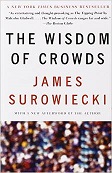Book Review - The Wisdom of Crowds
 The Wisdom of Crowds
The Wisdom of Crowds
James Surowiecki
ISBN-13: 978-0385721707
This book is in two parts. The first part explains Surowiecki’s theory of the wisdom of crowds: under the right circumstances, groups are remarkbly intelligent, and are often smarter than the smartest people in them. This can happen (so the theory goes) even if most of the people within a group are not especially well-informed or rational.
Think about that for a moment… A group of laymen can outperform experts. It seems so counterintuitive. What kind of a game changer would it be if it were true? (That’s rhetorical, but you can still send me your thoughts!)
The second part of the book consists of case studies. These are situations in which a crowd, which may consist of non-experts or include a small percentage of experts, outperform the experts alone. There are many case studies provided, most of which are rather interesting.
Are crowds actually wise?
Maybe.
Surowiecki does a great job explaining his theory. His writing and approach makes it very accessible to a wide audience. He provides a lot of case studies - around half the book!
But I’m still not convinced of the efficacy of the wisdom of crowds. The case studies in the book seem cherry-picked to support the theory. A reviewer on Amazon pointed out that the world of Wall Street provides plenty of negative examples to counterbalance the positive examples in the book.
If so, under what conditions?
The author proposes that most problems fall into one of three categories: cognition (something with one or more correct answers), coordination (characterized by a systemic solution), and cooperation (get self-interested and distrustful actors to achieve a common goal).
The book claims that for a crowd to be wise, it needs diversity, independence, decentralization, and aggregation. The first three are pretty clearly explained in the book, but the fourth is left rather vague. The book says to design the aggregation mechanism such that errors or incorrect answers distribute evenly (i.e. cancel out) and correct answers aggregate. That makes sense, but it’s not exactly practical advice - the book doesn’t really explain how to do this.
I think the theory is promising, but I have my reservations: the restrictions on the problem space, the difficulty of determining who makes up the crowd, and the complexity of aggregating the crowd’s solutions. I’m not the only one with these concerns: for more reading, check out this link and this one.